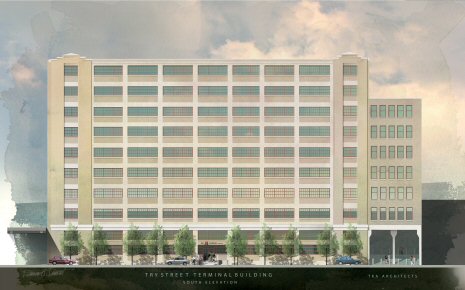GENERAL BUILDING DATA
BUILDING NAME & LOCATION:
Try Street Terminal Building
620 Second Avenue
Pittsburgh, PA 15219
BUILDING OCCUPANT NAME:
The Art Institute of Pittsburgh
OCCUPANCY OR FUNCTION TYPES:
-Residential
-Although the main purpose is to provide apartments for the Art Institute of Pittsburgh, other features include: an atrium, activities lounge, recreation space, first-floor retail space and possibly a convenience store and casual dining restaurant.
SIZE:
230,000 SF
NUMBER OF STORIES ABOVE GRADE: 9 Floor
TOTAL LEVELS: 10 Floors including the basement
PRIMARY PROJECT TEAM:
ARCHITECT: TKA ARCHITECTS
GENERAL CONTRACTOR: MASSARO CORPORATION
STRUCTURAL ENGINEER: THE KACHELLE GROUP
MECHANICAL ENGINEER: McKAMISH
PLUMBING ENGINEER: SAUER, INC.
ELECTRICAL ENGINEER:
STAR ELECTRIC COMPANY, INC.
FIRE PROTECTION:
RUTHRAUFF, INC.
DATES OF CONSTRUCTION:
OCTOBER 2005 – APRIL 2007
APPROXIMATE COST:
$15 Million
PROJECT DELIVERY METHOD:
Design - Build
ARCHITECTURE
ARCHITECTURE:
-The original industrial building was constructed in 1910.
-The façade of the building includes existing concrete and brick with the addition of the new historically accurate thermally broken insulated windows. The existing concrete window sills were also replaced with new cast stone.
-Renovations also included the addition of a light well in the core of the building on floors three though nine. The main purpose of the light well was to meet the code requirement of providing a window in each of the living areas.
MAJOR NATIONAL CODES:
ICC IBC 2003 (International Code Council)
OCCUPANCY CLASSIFICATION:
Residential, R-2
CONSTRUCTION TYPE:
1B – This construction type is typically found in mid-rise office and group R buildings. All of the building elements in 1B construction are made from noncombustible and fire resistive materials.
BUILDING ENVELOPE:
ROOF SYSTEM
-The roof system consists of the existing roof slab with a new roofing membrane over rigid insulation.
-A new 4” slab on deck was also added above the mechanical equipment penthouse.
EXTERIOR WALL SYSTEM
-Interior lightwell construction includes a corrugated metal panel supported by a 5” structural channel with 2” rigid insulation, a vapor barrier, and metal stud covered by a 5/8” gypsum wall board on the interior.
-Exterior walls were a mass wall construction. They were constructed of masonry and concrete. |
